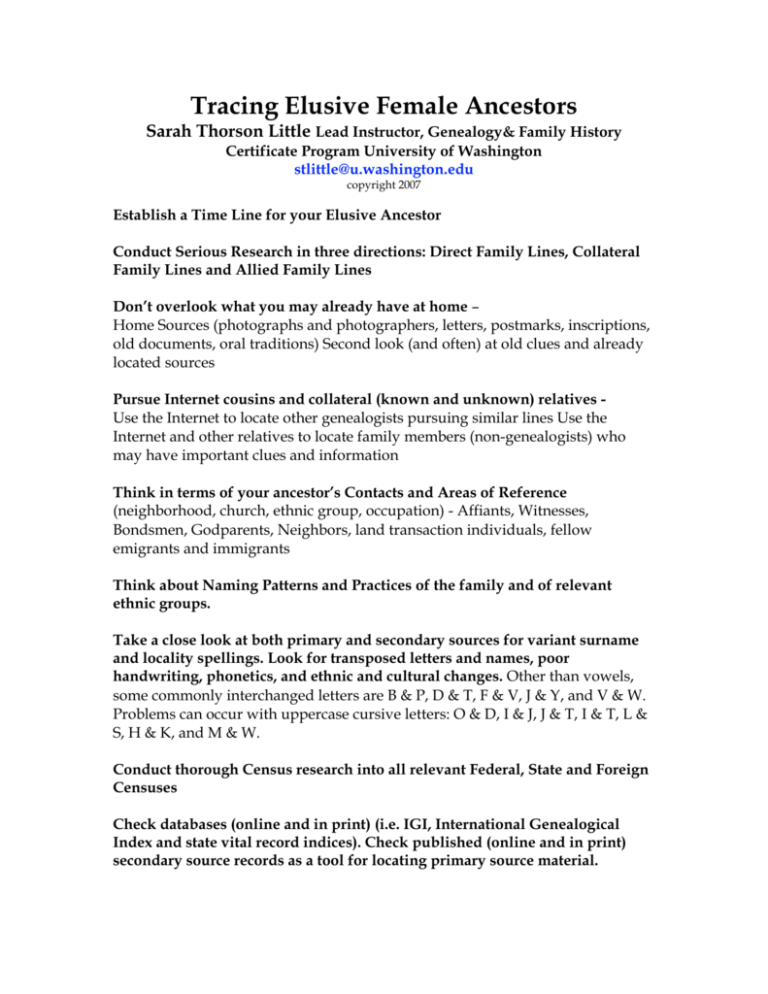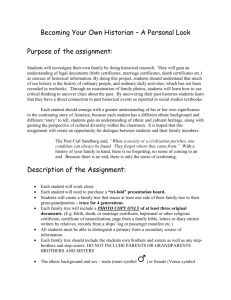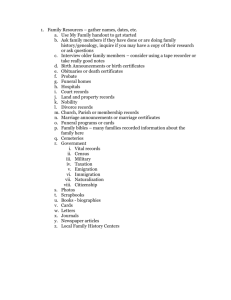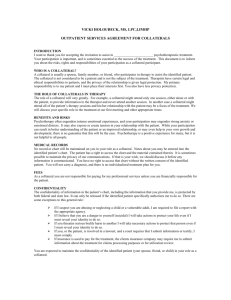Tracing Elusive Female Ancestors Sarah Thorson Little Lead
advertisement

Tracing Elusive Female Ancestors Sarah Thorson Little Lead Instructor, Genealogy& Family History Certificate Program University of Washington stlittle@u.washington.edu copyright 2007 Establish a Time Line for your Elusive Ancestor Conduct Serious Research in three directions: Direct Family Lines, Collateral Family Lines and Allied Family Lines Don’t overlook what you may already have at home – Home Sources (photographs and photographers, letters, postmarks, inscriptions, old documents, oral traditions) Second look (and often) at old clues and already located sources Pursue Internet cousins and collateral (known and unknown) relatives Use the Internet to locate other genealogists pursuing similar lines Use the Internet and other relatives to locate family members (non-genealogists) who may have important clues and information Think in terms of your ancestor’s Contacts and Areas of Reference (neighborhood, church, ethnic group, occupation) - Affiants, Witnesses, Bondsmen, Godparents, Neighbors, land transaction individuals, fellow emigrants and immigrants Think about Naming Patterns and Practices of the family and of relevant ethnic groups. Take a close look at both primary and secondary sources for variant surname and locality spellings. Look for transposed letters and names, poor handwriting, phonetics, and ethnic and cultural changes. Other than vowels, some commonly interchanged letters are B & P, D & T, F & V, J & Y, and V & W. Problems can occur with uppercase cursive letters: O & D, I & J, J & T, I & T, L & S, H & K, and M & W. Conduct thorough Census research into all relevant Federal, State and Foreign Censuses Check databases (online and in print) (i.e. IGI, International Genealogical Index and state vital record indices). Check published (online and in print) secondary source records as a tool for locating primary source material. Tracing Elusive Female Ancestors – continued – Sarah Thorson Little Seek Primary Sources such as: Vital Records: Death Certificates Birth Certificates Marriage Records (including applications, licenses and certificates) Divorce Records Religious Records: Baptism and Christening Records Marriage Records Burial Records Family Bibles Court Records Probate and Guardianship papers Naturalization Records Deeds and Land Related Records Military Pensions and other Military Records Emigration/Immigration and Passenger Lists Mortuary records and Cemetery lot purchases Often overlooked sources such as School Records, Diaries and membership in women‘s organizations; Seek Secondary Sources such as: Newspapers (local news, society news, anniversaries, legal notices, reunions) Obituaries (direct, collateral and allied lines) Cemeteries including tombstones, sexton‘s records and cemetery plots Biographical sketches Town and County Histories Church Histories Family Genealogies City Directories Seek Research Repositories and Libraries with records you might have missed: Local libraries and Historical Societies (especially vertical files and collections) Major libraries (NUCMC – National Union Catalog of Manuscript Collections) Study Women’s Legal rights in regard to property and inheritance; Study Laws in regard to women’s rights to citizenship, voting and pension applications. Familiarize yourself with legal terminology and abbreviations such as : Curtesy: A husband‘s interest in the property of his deceased wife; Dower right: The right of a widow to a life estate in 1/3 of all her husband‘s real estate owned at his death; Release of dower: Et ux., Et uxor.: and wife; Et al., and others; Feme covert: a married woman; Feme sole: a single woman (widowed, single, divorced); ANALYZE AND REANALYZE – Solve Identity Problems -- gather sufficient evidence to make conclusions. Project what you think, Make Hypotheses, but never make premature conclusions! If you do, don’t publish them on the Internet!!! Establish a Broad Foundation of Solid Evidence and CITE ALL YOUR SOURCES











